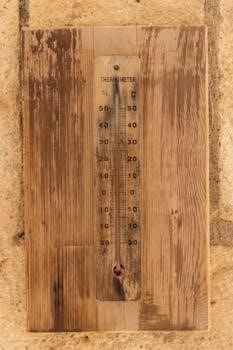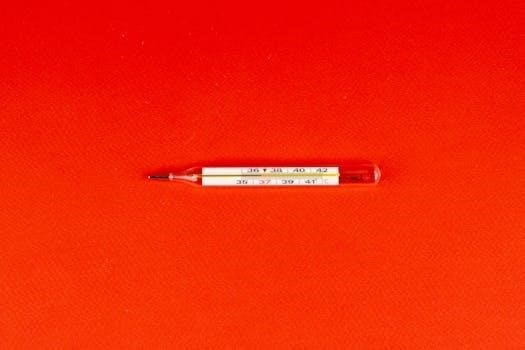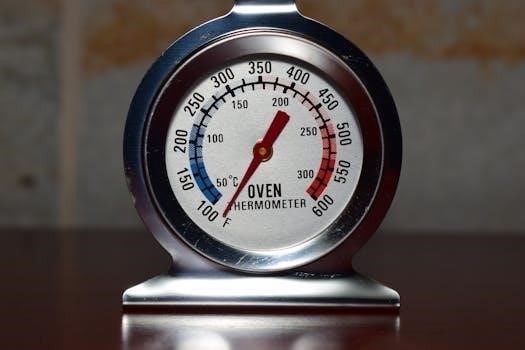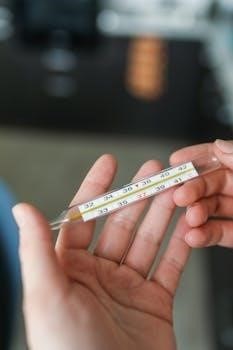Understanding temperature conversions is crucial in a globalized world․ This guide introduces the process of converting Fahrenheit to Celsius, offering practical tools like printable PDF tables for easy reference․

Understanding Fahrenheit and Celsius Scales
The Fahrenheit and Celsius scales differ significantly in their origins and degree intervals․ Grasping these fundamental differences is the first step toward mastering temperature conversion using tools like a PDF chart․
Origins and Definitions
The Fahrenheit scale, developed by Daniel Gabriel Fahrenheit, is defined by the freezing point of water at 32°F and the boiling point at 212°F․ Anders Celsius created the Celsius scale, originally setting 0°C as the boiling point and 100°C as the freezing point of water․ This was later inverted to its current form, where 0°C represents the freezing point and 100°C represents the boiling point․ Understanding these different reference points is crucial when using a Fahrenheit Celsius conversion table PDF․
Okay, here is the requested content⁚
Key Differences between Fahrenheit and Celsius
The primary distinction lies in their reference points for freezing and boiling water⁚ 32°F and 212°F for Fahrenheit, versus 0°C and 100°C for Celsius․ A Fahrenheit degree is also smaller than a Celsius degree․ These differences necessitate a conversion formula for accurate temperature comparisons; Utilizing a Fahrenheit Celsius conversion table PDF helps bypass manual calculations․ The Fahrenheit scale is predominantly used in the United States, while Celsius is prevalent in most other countries for everyday temperature measurements․
The Fahrenheit to Celsius Conversion Formula
Converting Fahrenheit to Celsius requires a specific formula to account for the scales’ different starting points and degree sizes․ This section will explain the formula and provide examples․
The Mathematical Formula Explained
The formula to convert Fahrenheit (F) to Celsius (C) is⁚ C = (F ー 32) × 5/9․ This equation accounts for the offset in the freezing points of the two scales․ Water freezes at 32°F and 0°C․ Subtracting 32 from the Fahrenheit temperature adjusts for this difference․ The multiplication by 5/9 is due to Celsius having 100 degrees between freezing and boiling, while Fahrenheit has 180 degrees․ This ratio simplifies the conversion, providing an accurate Celsius equivalent․
Step-by-Step Conversion Example
Let’s convert 68°F to Celsius․ First, subtract 32 from the Fahrenheit temperature⁚ 68 ⎼ 32 = 36․ Next, multiply the result by 5/9: 36 × (5/9) = 20․ Therefore, 68°F is equal to 20°C․ This process demonstrates the application of the formula․ You subtract the offset and then scale the value to match the Celsius degree size․ Remember this sequence for accurate and quick temperature conversions․ Using this method, one can easily convert Fahrenheit to Celsius without online calculators or conversion tables․
Creating a Fahrenheit to Celsius Conversion Table
Conversion tables offer a quick reference for frequently needed temperature equivalents․ Building your own table or using a pre-made PDF can save time and effort․
Benefits of Using a Conversion Table
Utilizing a Fahrenheit to Celsius conversion table offers numerous advantages․ It eliminates the need for manual calculations, saving considerable time and reducing the likelihood of errors․ Pre-calculated values are readily accessible, promoting efficiency in various tasks․ These tables are particularly helpful in fields requiring frequent temperature conversions, such as cooking, scientific research, and weather forecasting․ They also serve as excellent educational tools for understanding the relationship between the two temperature scales․ Conversion tables are easily printable, providing a convenient reference at home, in the lab, or on the go․
How to Read and Use a Conversion Table Effectively
Effectively using a Fahrenheit to Celsius conversion table involves understanding its layout․ Typically, one column displays Fahrenheit values, while the adjacent column presents corresponding Celsius values․ To convert, locate the known Fahrenheit temperature in the first column and read across to find its Celsius equivalent․ For quick estimations, scan the table for values close to the desired temperature․ Some tables include incremental values, enhancing precision․ Pay attention to the table’s range to ensure it covers the temperatures needed․ Conversion tables are invaluable tools for swift and accurate temperature scale transitions․

Common Fahrenheit to Celsius Conversion Values
Certain temperatures are frequently converted․ This section highlights common Fahrenheit to Celsius conversions, including water’s freezing and boiling points, and normal human body temperature, offering a practical reference․
Freezing and Boiling Points of Water
Water’s freezing and boiling points serve as fundamental reference points in thermometry․ In Fahrenheit, water freezes at 32°F and boils at 212°F․ Understanding these values in Celsius is essential for various applications․ A conversion table or online calculator can quickly determine these Celsius equivalents․ Freezing is 0°C, and boiling is 100°C․ These values are critical in science, cooking, and daily life․ Using a printable Fahrenheit to Celsius PDF table is a convenient way to have these conversions readily available, ensuring accuracy and efficiency in temperature-related tasks․
Human Body Temperature
Normal human body temperature is typically around 98․6°F․ This translates to approximately 37°C․ Deviations from this range can indicate fever or hypothermia․ Accurately converting between Fahrenheit and Celsius is vital in healthcare․ Using a Fahrenheit to Celsius conversion table ensures quick and precise temperature readings․ A printable PDF version is especially useful in clinical settings․ Monitoring body temperature helps in diagnosis and treatment․ Having readily available conversion tools minimizes errors․ Understanding normal and abnormal temperature ranges in both scales is crucial for health professionals and individuals alike․ Therefore, easy access to conversion resources is important․
Tools for Fahrenheit to Celsius Conversion
Several tools simplify Fahrenheit to Celsius conversions․ Online calculators offer instant results․ Mobile apps provide convenient conversions on the go, and printable PDF tables are readily available for quick reference․
Online Conversion Calculators
Numerous websites offer free Fahrenheit to Celsius conversion calculators․ These tools provide a quick and easy way to convert temperatures without manual calculations․ Simply enter the Fahrenheit value, and the calculator instantly displays the Celsius equivalent․ Many calculators also offer reverse conversion, from Celsius to Fahrenheit․ These online tools often include additional features, such as the option to convert to other temperature scales like Kelvin․ Some sites provide printable conversion charts in PDF format, making them a versatile resource for temperature conversions․ These calculators are ideal for quick, accurate, and convenient temperature conversions․
Mobile Apps for Temperature Conversion
Mobile apps provide convenient temperature conversions on the go․ Available for both iOS and Android, these apps allow users to quickly convert Fahrenheit to Celsius and vice versa․ Many apps offer additional features, such as real-time temperature updates and the ability to convert between various units, including Kelvin and Rankine․ Some apps also include historical temperature data and graphing capabilities․ These tools often feature user-friendly interfaces and offline functionality, making them invaluable for travel and daily use․ Look for apps that offer printable conversion charts in PDF format for easy reference․

Applications of Fahrenheit and Celsius Scales
Fahrenheit and Celsius scales are used in different contexts globally․ Understanding their applications in everyday life, science, and industry is crucial for effective communication and accurate measurements across various fields․
Everyday Use in Different Countries
The Fahrenheit scale is primarily used in the United States for daily temperature reporting, weather forecasts, and household thermostats․ Celsius, on the other hand, is the standard in most other countries worldwide for these same applications․ This difference often requires conversions for individuals traveling or interacting with information from different regions․ For example, understanding cooking temperatures or adjusting clothing choices based on a foreign weather forecast necessitates a grasp of both scales․ Therefore, familiarizing oneself with common conversions is incredibly useful in navigating diverse environments and communications․
Scientific and Industrial Applications
While Celsius is the standard in many scientific contexts, Fahrenheit still appears in specific engineering and industrial fields, particularly in the United States․ Data logging, material testing, and process control might involve Fahrenheit measurements, necessitating accurate conversions to Celsius for analysis or integration with systems using the metric standard․ High-temperature coatings, for example, may have performance specifications defined using Fahrenheit, even if the underlying research uses Celsius․ Understanding both scales is crucial for professionals working across international collaborations or with legacy systems․
Common Mistakes in Fahrenheit to Celsius Conversion
A frequent error involves directly applying a simple ratio without accounting for the offset between the scales․ Forgetting to subtract 32 from the Fahrenheit temperature before multiplying by 5/9 is a common pitfall․ Another mistake stems from rounding intermediate values prematurely, leading to inaccurate final results․ When using online calculators or conversion tables, ensure the source is reliable and the input is correctly formatted․ Always double-check your calculations, especially in critical applications, to avoid potentially significant errors in temperature-sensitive processes or analyses․ Using a conversion table can help reduce those risks․

Resources for Further Learning
Expand your knowledge with online resources, including tutorials and articles detailing the nuances of temperature conversion․ Seek out printable conversion charts and PDFs for convenient, offline reference when needed․
Online Articles and Tutorials
Delve deeper into Fahrenheit to Celsius conversions through readily accessible online articles․ These resources often provide detailed explanations of the formulas and practical applications, aiding comprehension․ Look for tutorials that offer step-by-step guidance on performing conversions, sometimes including interactive elements․ Many websites offer converters and detailed guides․
Explore resources that demonstrate real-world examples․ Interactive tools and quizzes are there to help you test your knowledge․ Online platforms often host communities where you can ask questions․
Find educational resources to master temperature conversions․
Printable Conversion Charts and PDFs
For quick and easy reference, printable Fahrenheit to Celsius conversion charts are invaluable․ These charts, often available as PDFs, provide a table of corresponding temperatures, eliminating the need for manual calculations․ A well-designed chart offers clear readability․
Many resources provide charts tailored for specific temperature ranges, like cooking, body temperatures, or scientific applications․ Download and print these charts for convenient access in the kitchen, laboratory, or classroom․ They ensure accurate conversions at a glance․
Use these handy resources to simplify temperature-related tasks․
Achieving proficiency in Fahrenheit to Celsius conversion is more accessible than ever, thanks to numerous resources․ From online calculators to printable PDF charts, converting between scales is simplified; With consistent practice, one can easily master the art of temperature conversions․
Understanding the formula helps one grasp the relationship between the two scales; Using conversion tables and charts further streamlines the process․ Being able to convert accurately is a valuable skill․ So, make the most of the available resources and become a conversion expert!